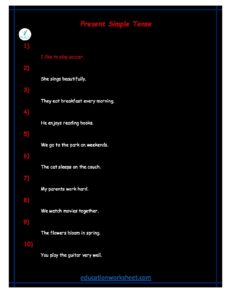how to converting Present Simple Tense positive sentences to interrogative form
how to converting Present Simple Tense positive sentences to interrogative form
The Present Simple tense is one of the fundamental building blocks of English grammar. It is used to express habitual actions, general truths, and routines. In its positive form, it helps us make statements about what happens regularly or facts that are always true. However, in various communication situations, we may need to convert these positive statements into interrogative sentences to ask questions and seek information. In this comprehensive guide, we will delve into the intricacies of converting Present Simple tense positive sentences to interrogative form.
- Understanding the Present Simple Tense: Before we dive into converting sentences, let’s briefly review the Present Simple tense. It is typically formed by using the base form of the verb (e.g., “eat,” “work,” “live”) for most subjects, but we add an “-s” to the verb when the subject is in the third person singular (he, she, it). For example:
- I eat breakfast every morning. (Positive)
- She eats breakfast every morning. (Positive)
- Identifying the Subject: To convert a positive sentence into an interrogative one, the first step is to identify the subject. The subject is the noun or pronoun that performs the action of the verb. Once you’ve identified the subject, you can rearrange the sentence to form a question.
- Inverting the Subject and Verb: In English, forming an interrogative sentence often involves inverting the subject and the verb. In the case of Present Simple tense, we typically start the question with an auxiliary verb like “do” or “does” (for most subjects) or “is” (for the third person singular). Here’s how it works:how to converting Present Simple Tense positive sentences to interrogative form
- Positive: They swim in the pool.
- Interrogative: Do they swim in the pool?
- Positive: She eats dinner at 7 PM.
- Interrogative: Does she eat dinner at 7 PM?how to converting Present Simple Tense positive sentences to interrogative form

In these examples, “do” is used for subjects like “They,” while “does” is used for “She.”
- Adding the Question Word: Depending on the type of information you want to gather, you may also need to include a question word like “who,” “what,” “when,” “where,” “why,” or “how” at the beginning of the sentence. These question words help specify the nature of the question. For example:
- Positive: He goes to school.
- Interrogative: Where does he go?
- Positive: They study English.
- Interrogative: What do they study?how to converting Present Simple Tense positive sentences to interrogative form
- Forming Yes/No Questions: In many cases, you might want to ask a simple yes/no question. In such instances, you can use the auxiliary verb “do” or “does” (for most subjects) or “is” (for the third person singular) without a question word. Here’s how:
- Positive: You like ice cream.
- Interrogative: Do you like ice cream?
- Positive: She plays the piano.
- Interrogative: Does she play the piano?
- Subject-Verb Agreement: It’s crucial to maintain subject-verb agreement when converting sentences to interrogative form. In the Present Simple tense, the verb must agree with the subject. Remember to use “do” for most subjects and “does” for the third person singular:
- Positive: They visit their grandparents.
- Interrogative: Do they visit their grandparents?
- Positive: He watches TV.
- Interrogative: Does he watch TV?
- Negative Interrogative Sentences: You can also convert negative Present Simple sentences into interrogative form by using the appropriate auxiliary verb and inverting the subject and auxiliary verb. Here’s how:
- Negative: She doesn’t like broccoli.
- Negative Interrogative: Does she not like broccoli?
- Negative: They don’t speak French.
- Negative Interrogative: Do they not speak French?
- Contracted Forms: In spoken English, it’s common to use contracted forms when forming questions. For example:
- Positive: She does not (doesn’t) exercise.
- Interrogative: Doesn’t she exercise?
- Positive: You do not (don’t) work on weekends.
- Interrogative: Don’t you work on weekends?
how to converting Present Simple Tense positive sentences to interrogative form

- Tag Questions: Tag questions are short questions added to the end of a sentence to seek confirmation or agreement. They often follow a positive sentence with a negative tag or vice versa. Here are some examples:
- Positive: He travels a lot, doesn’t he?
- Positive: She likes pizza, doesn’t she?
- Negative: They don’t have a car, do they?
- Negative: You can swim, can’t you?
- Special Cases: In some cases, the verb “to be” (am, is, are) is used in the Present Simple tense. Converting these sentences into interrogative form involves a simple inversion with the verb “to be”:
- Positive: They are happy.
- Interrogative: Are they happy?
- Positive: She is a teacher.
- Interrogative: Is she a teacher?
how to converting Present Simple Tense positive sentences to interrogative form
- Asking About Frequency: When you want to ask how often something happens in the Present Simple tense, you can use question words like “often,” “usually,” “always,” or “never.” Here’s how:
- Positive: He exercises every day.
- Interrogative: How often does he exercise?
- Positive: She always arrives on time.
- Interrogative: How often does she arrive on time?
- Practice and Application: To become proficient at converting Present Simple tense positive sentences into interrogative form, it’s essential to practice regularly. Try creating your own sentences and converting them into questions. You can also engage in conversation and use this skill to ask questions about daily routines, preferences, or habits.
In conclusion, converting Present Simple tense positive sentences to interrogative form is a fundamental aspect of English grammar. By identifying the subject, using appropriate auxiliary verbs, and possibly incorporating question words, you can effectively turn statements into questions. This skill is invaluable for communication, as it allows you to gather information, clarify details, and engage in meaningful conversations. With practice, you can master the art of forming interrogative sentences in the Present Simple tense and enhance your overall English language proficiency.
how to converting Present Simple Tense positive sentences to interrogative form

